2018 VOLVO V60 CROSS COUNTRY wheel
[x] Cancel search: wheelPage 371 of 404
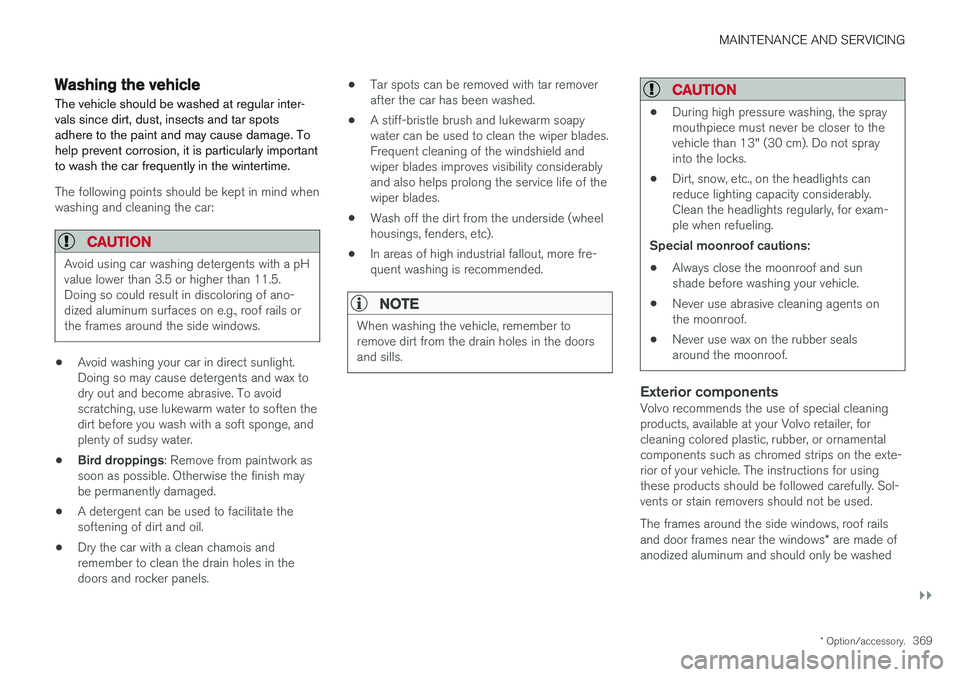
MAINTENANCE AND SERVICING
}}
* Option/accessory.369
Washing the vehicle
The vehicle should be washed at regular inter- vals since dirt, dust, insects and tar spotsadhere to the paint and may cause damage. Tohelp prevent corrosion, it is particularly importantto wash the car frequently in the wintertime.
The following points should be kept in mind when washing and cleaning the car:
CAUTION
Avoid using car washing detergents with a pH value lower than 3.5 or higher than 11.5.Doing so could result in discoloring of ano-dized aluminum surfaces on e.g., roof rails orthe frames around the side windows.
• Avoid washing your car in direct sunlight. Doing so may cause detergents and wax todry out and become abrasive. To avoidscratching, use lukewarm water to soften thedirt before you wash with a soft sponge, andplenty of sudsy water.
• Bird droppings
: Remove from paintwork as
soon as possible. Otherwise the finish maybe permanently damaged.
• A detergent can be used to facilitate thesoftening of dirt and oil.
• Dry the car with a clean chamois andremember to clean the drain holes in thedoors and rocker panels. •
Tar spots can be removed with tar removerafter the car has been washed.
• A stiff-bristle brush and lukewarm soapywater can be used to clean the wiper blades.Frequent cleaning of the windshield andwiper blades improves visibility considerablyand also helps prolong the service life of thewiper blades.
• Wash off the dirt from the underside (wheelhousings, fenders, etc).
• In areas of high industrial fallout, more fre-quent washing is recommended.
NOTE
When washing the vehicle, remember to remove dirt from the drain holes in the doorsand sills.
CAUTION
•
During high pressure washing, the spray mouthpiece must never be closer to thevehicle than 13" (30 cm). Do not sprayinto the locks.
• Dirt, snow, etc., on the headlights canreduce lighting capacity considerably.Clean the headlights regularly, for exam-ple when refueling.
Special moonroof cautions:
• Always close the moonroof and sunshade before washing your vehicle.
• Never use abrasive cleaning agents onthe moonroof.
• Never use wax on the rubber sealsaround the moonroof.
Exterior componentsVolvo recommends the use of special cleaning products, available at your Volvo retailer, forcleaning colored plastic, rubber, or ornamentalcomponents such as chromed strips on the exte-rior of your vehicle. The instructions for usingthese products should be followed carefully. Sol-vents or stain removers should not be used. The frames around the side windows, roof rails and door frames near the windows
* are made of
anodized aluminum and should only be washed
Page 372 of 404
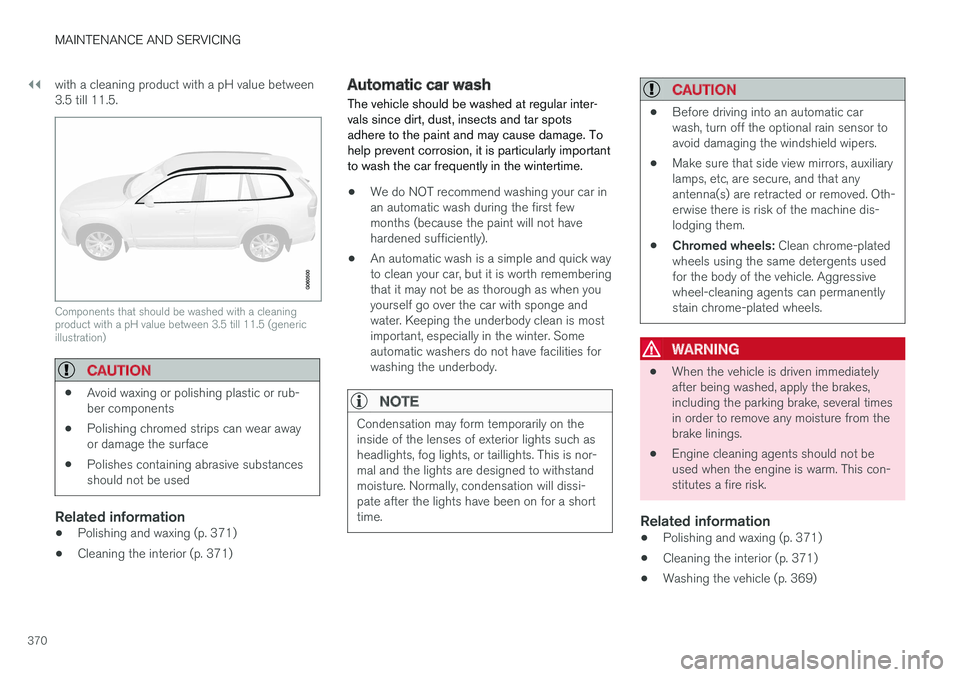
||
MAINTENANCE AND SERVICING
370with a cleaning product with a pH value between 3.5 till 11.5.
Components that should be washed with a cleaning product with a pH value between 3.5 till 11.5 (genericillustration)
CAUTION
•
Avoid waxing or polishing plastic or rub- ber components
• Polishing chromed strips can wear awayor damage the surface
• Polishes containing abrasive substancesshould not be used
Related information
• Polishing and waxing (p. 371)
• Cleaning the interior (p. 371)
Automatic car wash
The vehicle should be washed at regular inter- vals since dirt, dust, insects and tar spotsadhere to the paint and may cause damage. Tohelp prevent corrosion, it is particularly importantto wash the car frequently in the wintertime.
• We do NOT recommend washing your car in an automatic wash during the first fewmonths (because the paint will not havehardened sufficiently).
• An automatic wash is a simple and quick wayto clean your car, but it is worth rememberingthat it may not be as thorough as when youyourself go over the car with sponge andwater. Keeping the underbody clean is mostimportant, especially in the winter. Someautomatic washers do not have facilities forwashing the underbody.
NOTE
Condensation may form temporarily on the inside of the lenses of exterior lights such asheadlights, fog lights, or taillights. This is nor-mal and the lights are designed to withstandmoisture. Normally, condensation will dissi-pate after the lights have been on for a shorttime.
CAUTION
•
Before driving into an automatic car wash, turn off the optional rain sensor toavoid damaging the windshield wipers.
• Make sure that side view mirrors, auxiliarylamps, etc, are secure, and that anyantenna(s) are retracted or removed. Oth-erwise there is risk of the machine dis-lodging them.
• Chromed wheels:
Clean chrome-plated
wheels using the same detergents usedfor the body of the vehicle. Aggressivewheel-cleaning agents can permanentlystain chrome-plated wheels.
WARNING
• When the vehicle is driven immediately after being washed, apply the brakes,including the parking brake, several timesin order to remove any moisture from thebrake linings.
• Engine cleaning agents should not beused when the engine is warm. This con-stitutes a fire risk.
Related information
•
Polishing and waxing (p. 371)
• Cleaning the interior (p. 371)
• Washing the vehicle (p. 369)
Page 374 of 404
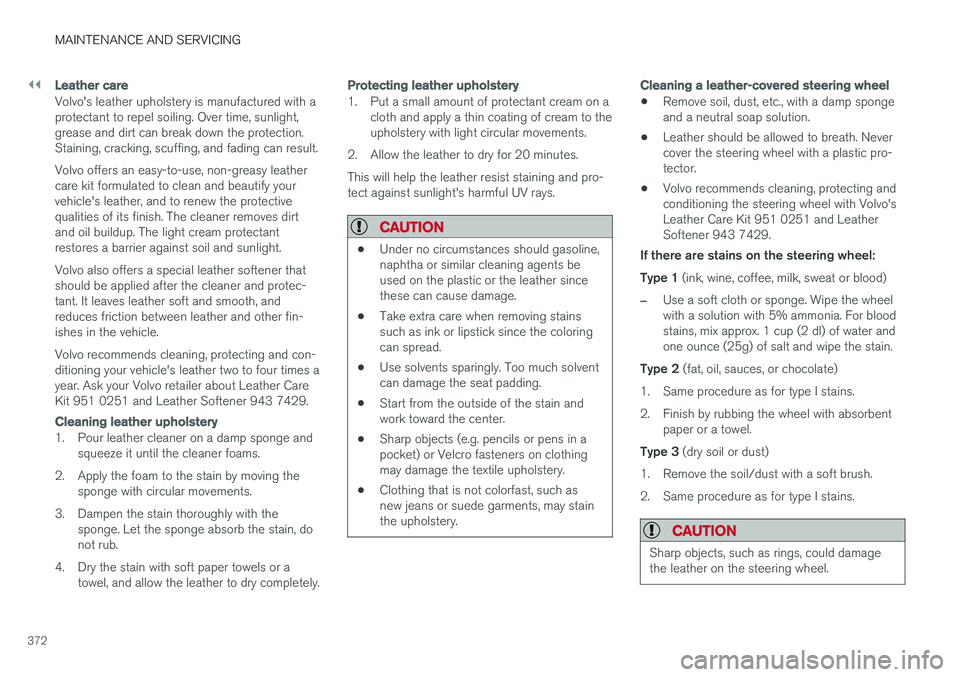
||
MAINTENANCE AND SERVICING
372
Leather care
Volvo's leather upholstery is manufactured with a protectant to repel soiling. Over time, sunlight,grease and dirt can break down the protection.Staining, cracking, scuffing, and fading can result. Volvo offers an easy-to-use, non-greasy leather care kit formulated to clean and beautify yourvehicle's leather, and to renew the protectivequalities of its finish. The cleaner removes dirtand oil buildup. The light cream protectantrestores a barrier against soil and sunlight. Volvo also offers a special leather softener that should be applied after the cleaner and protec-tant. It leaves leather soft and smooth, andreduces friction between leather and other fin-ishes in the vehicle. Volvo recommends cleaning, protecting and con- ditioning your vehicle's leather two to four times ayear. Ask your Volvo retailer about Leather CareKit 951 0251 and Leather Softener 943 7429.
Cleaning leather upholstery
1. Pour leather cleaner on a damp sponge andsqueeze it until the cleaner foams.
2. Apply the foam to the stain by moving the sponge with circular movements.
3. Dampen the stain thoroughly with the sponge. Let the sponge absorb the stain, do not rub.
4. Dry the stain with soft paper towels or a towel, and allow the leather to dry completely.
Protecting leather upholstery
1. Put a small amount of protectant cream on acloth and apply a thin coating of cream to the upholstery with light circular movements.
2. Allow the leather to dry for 20 minutes. This will help the leather resist staining and pro- tect against sunlight's harmful UV rays.
CAUTION
• Under no circumstances should gasoline, naphtha or similar cleaning agents beused on the plastic or the leather sincethese can cause damage.
• Take extra care when removing stainssuch as ink or lipstick since the coloringcan spread.
• Use solvents sparingly. Too much solventcan damage the seat padding.
• Start from the outside of the stain andwork toward the center.
• Sharp objects (e.g. pencils or pens in apocket) or Velcro fasteners on clothingmay damage the textile upholstery.
• Clothing that is not colorfast, such asnew jeans or suede garments, may stainthe upholstery.
Cleaning a leather-covered steering wheel
• Remove soil, dust, etc., with a damp sponge and a neutral soap solution.
• Leather should be allowed to breath. Nevercover the steering wheel with a plastic pro-tector.
• Volvo recommends cleaning, protecting andconditioning the steering wheel with Volvo'sLeather Care Kit 951 0251 and LeatherSoftener 943 7429.
If there are stains on the steering wheel: Type 1 (ink, wine, coffee, milk, sweat or blood)
–Use a soft cloth or sponge. Wipe the wheel with a solution with 5% ammonia. For bloodstains, mix approx. 1 cup (2 dl) of water andone ounce (25g) of salt and wipe the stain.
Type 2 (fat, oil, sauces, or chocolate)
1. Same procedure as for type I stains.
2. Finish by rubbing the wheel with absorbent paper or a towel.
Type 3 (dry soil or dust)
1. Remove the soil/dust with a soft brush.
2. Same procedure as for type I stains.
CAUTION
Sharp objects, such as rings, could damage the leather on the steering wheel.
Page 382 of 404

||
SPECIFICATIONS
380
Dimensions–V60CC
PositionDimension in. (mm)
A Ground clearance (curb weight + 2 people) A
7.5 (191)
B Wheelbase 109.2 (2774)
C Length 182.6 (4637)
D Load length, floor, seatback down 68.9 (1749)
E Load length, floor 38.5 (978)
F Height 60.8 (1545)Position Dimension in. (mm)
G Load height 25.9 (658)
H Track, front 63.7 (1619)B
/
63.3 (1609) C
I Track, rear 62.1 (1577)B
61.7 (1567) C
J Load width, floor 42.6 (1082)
K Width 73.5 (1866)Position Dimension in. (mm)
L Width incl. door mirrors (folded
out) 82.6 (2097)
M Width incl. door mirrors (folded in) 74.8 (1899)
AVaries slightly depending on tire size, optional sport chassis, etc.
B with 50 mm offset
C with 55 mm offset
Page 383 of 404
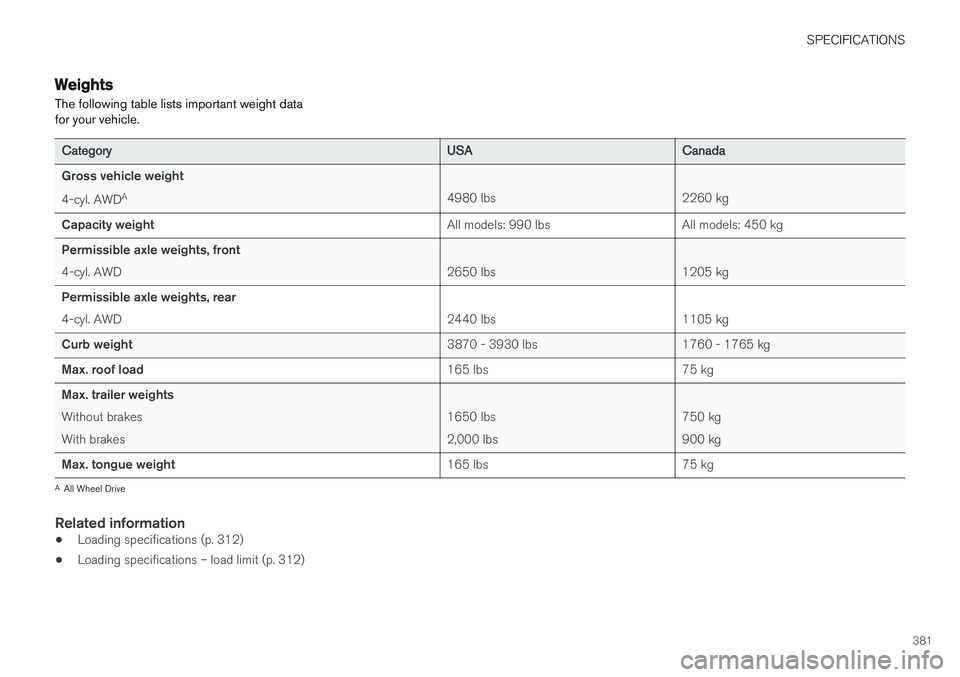
SPECIFICATIONS
381
Weights The following table lists important weight data for your vehicle.
CategoryUSACanada
Gross vehicle weight 4-cyl. AWD A
4980 lbs 2260 kg
Capacity weight All models: 990 lbs All models: 450 kg
Permissible axle weights, front
4-cyl. AWD 2650 lbs 1205 kg
Permissible axle weights, rear 4-cyl. AWD 2440 lbs 1105 kg
Curb weight 3870 - 3930 lbs 1760 - 1765 kg
Max. roof load 165 lbs 75 kg
Max. trailer weightsWithout brakes With brakes 1650 lbs2,000 lbs750 kg900 kg
Max. tongue weight 165 lbs 75 kg
A
All Wheel Drive
Related information
• Loading specifications (p. 312)
• Loading specifications – load limit (p. 312)
Page 387 of 404

SPECIFICATIONS
385
Coolant – specification and volume The table lists coolant volumes and specifica- tions.
SystemVolume Specification
B4204T11 8.7 US qts. (8.3 liters) Coolant with corrosion inhibi-tor mixed withwater (50/50mix), see pack-aging.
Related information
•
Engine compartment – coolant (p. 342)
Transmission oil – specification and volumes The table lists transmission oil 1
volumes and
specifications.
Automatic transmis-sion Volume
Specifica-tion
TF-80SD 7.4 US qts (7 liters) Transmis- sion fluidAW1
TG-81SC 7 US qts ( 6.6
liters)
TF-71SC 7.1 US qts (6.8 liters)
Related information
•Label information (p. 376)
Brake fluid – specification and volume
Brake fluid transfers braking force when the brake pedal is depressed to the master cylinderand to the slave cylinders on each wheel.
Specification: Volvo Original Dot 4 class 6 or
equivalent Volume: 0.63 US qts (0.6 liters)
Related information
•Engine compartment – brake fluid (p. 343)
1
Under normal driving conditions the transmission oil does not need changing during its service life. However, it may be necessary under adverse driving conditions.
Page 400 of 404

INDEX
398Rearview mirror
auto-dim function 108
compass 109
Rear window defroster 108
Recalls 28
Recalls, child restraints 50
Refrigerant 388
Refueling 286, 287 fuel filler cap 290
fuel filler door 289, 290
fuel tank volume 386
Registering child restraints 50 Remote control private locking 158
Remote key 152, 153, 154, 156, 159 approach lighting 155
immobilizer 154
key blade 152, 153, 154, 156, 157,158 , 159
locking the vehicle 155
replacing the battery 160
unlocking the vehicle 155
Reporting safety defects 29
Roadside Assistance 25
Road sign information (RSI) 178
Roof loads 146
S
Safety, occupant 28
Safety defects, reporting 29
Safety mode 46Seat belt reminder 32
Seat belts Automatic locking retractor/Emergency
locking retractor 50
buckling 31
maintenance 31
pretensioners 30
reminder 32
reminder warning light 77
securing child restraint systems 52, 54, 56
unbuckling 31
use during pregnancy 33
using 30
Seats, front 83, 84
Sensus 115Service connected service booking 335
Shiftlock 15 override 267
Side door mirrors 106, 107
Side impact airbags 41
Sign information (RSI) 178
Snow chains 315
Snow tires 315, 316
Spare tire 306
Spin control 174, 175SRS 33
Stability system 174, 175, 176 Corner Traction Control (CTC) 174
Engine Drag Control (EDC) 174
indicator light 76
Start/Stop (engine function) 268, 269, 270, 271, 272
Starting the engine 258 remote start 260
with keyless drive 258
Starting the vehicle after a crash (crash mode) 46, 47
Start inhibitor (immobilizer) 154
Steel grid in cargo compartment 150Steering wheel adjusting 91
heated 92
horn 91
keypad 91
Steering wheel paddles 91
Stone chips, touching up 373
Page 402 of 404
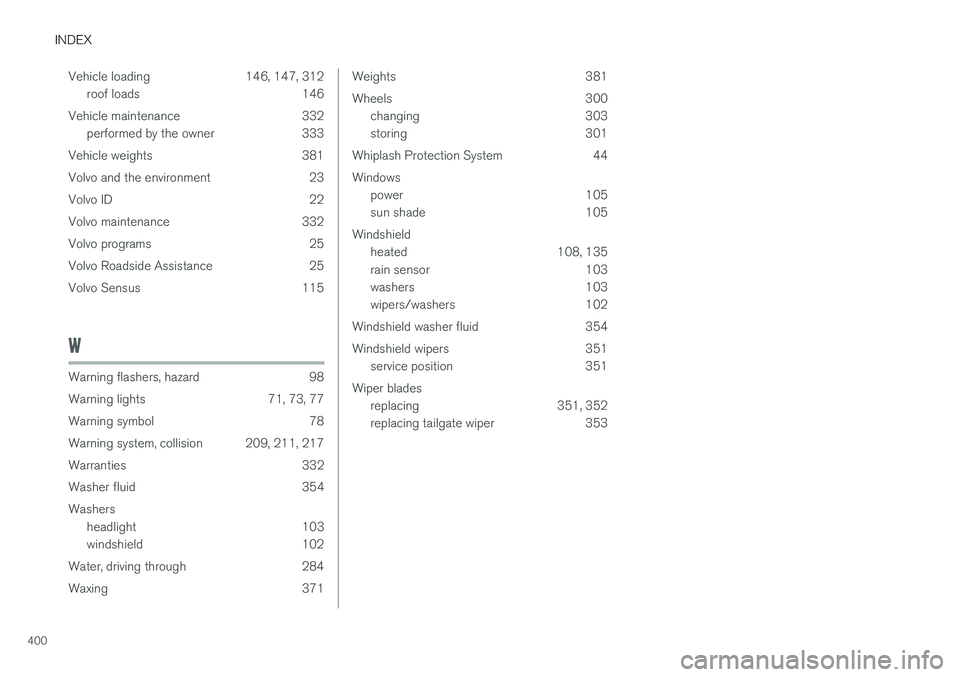
INDEX
400Vehicle loading 146, 147, 312
roof loads 146
Vehicle maintenance 332 performed by the owner 333
Vehicle weights 381
Volvo and the environment 23
Volvo ID 22
Volvo maintenance 332
Volvo programs 25
Volvo Roadside Assistance 25
Volvo Sensus 115
W
Warning flashers, hazard 98
Warning lights 71, 73, 77
Warning symbol 78
Warning system, collision 209, 211, 217
Warranties 332
Washer fluid 354Washers headlight 103
windshield 102
Water, driving through 284
Waxing 371
Weights 381
Wheels 300 changing 303
storing 301
Whiplash Protection System 44 Windows power 105
sun shade 105
Windshield heated 108, 135
rain sensor 103
washers 103
wipers/washers 102
Windshield washer fluid 354
Windshield wipers 351 service position 351
Wiper blades replacing 351, 352
replacing tailgate wiper 353